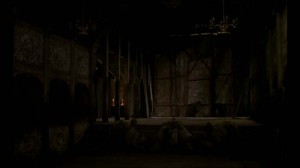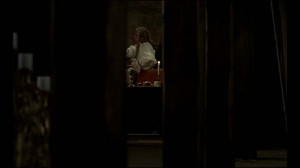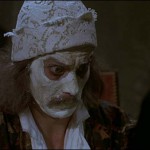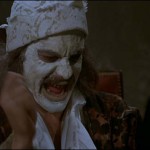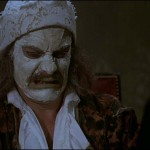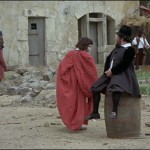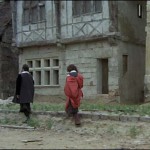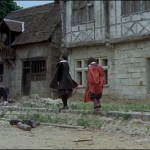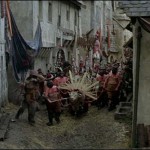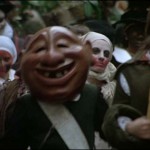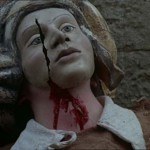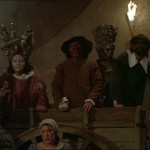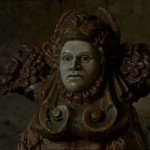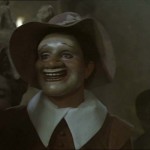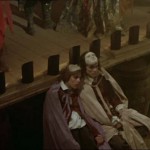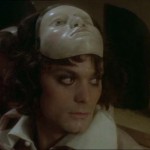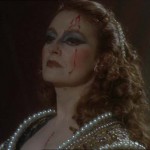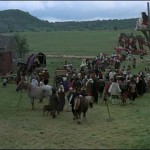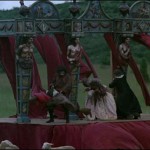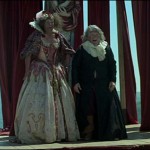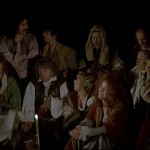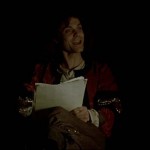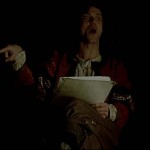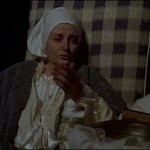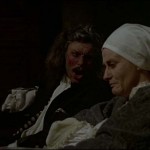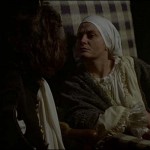Were it not for the well-sustained intermedial formula that characterises Ariane Mnouchkine’s Molière, ou la vie d’un honnête homme (France, 1978), the film might appear to a distracted viewer as little more than a big-budget movie displaying an above-average predilection for carefully composed tableaux. The director of the film is a well-known and lauded theatre director, founder and primary force behind the company Théâtre du Soleil. Her troupe was intimately involved in the production of the film, supplying the bulk of the main cast and bringing to the set its collective experience of the stage. The meeting between the film crew and the theatre company has been described by Mnouchkine as an “apprentissage réciproque” or shared learning process. [1] According to Mnouchkine, film and theatre should be seen as mutually beneficial, as “the craft of theatre has everything to gain from certain cinema technology … and the vast technology of cinema has much to gain from finding solutions involving paper, thread, glue, bits of silk …”. [2] The décor of the film, closely replicating the feel of Dutch seventeenth century painting, was expensively put together by a team led by Guy-Claude François, and it ended up being very much a showcase of artisanship—as was the large number of masks employed by the film, designed by another important member of the Soleil team, Erhard Stiefel.
This set of specifications (a theatre director working in film with a theatre company to tell the story of another theatre company), albeit highly promising, does not guarantee on its own the intermedial complexity of the project. The concept of intermediality can encompass a wide range of concerns without overreaching itself. Any phenomenon that involves a relation between two media can, in a very generous sense, be a legitimate object of enquiry for intermediality. The study of theatricality in film is thus easily subsumable within this relatively recent problematic. Theatricality can have multiple understandings, ranging from the mere referencing of theatre to what is called in intermediality theory a “formal intermedial imitation”, namely an “attempt to shape the material” of a medium “in such a manner that it acquires a formal resemblance to typical features or structures of another medium”. [3] It will be the purpose of this analysis to identify and examine those sequences in the film which best hypostasise the idea of a deliberately weakened distinction between theatre and theatricality, a strategy oriented towards a cinema audience.
At the time of its release, the film was poorly received by some critics. Mnouchkine has talked about a veritable “Cannes massacre”. [4] The film has yet to recover from the hostility with which it was initially greeted. To take but two examples, Vincent Canby of The New York Times wrote in 1979 that the film was “full of the sort of theatrical clichés associated with the once-thought radical theatre of improvisation of the ‘60s”, lacking in “arresting images” and realised “in the manner of failed Fellini”. [5] Canby was very clear about what he considered to be the film’s main fault: the director had made a prior career in theatre and “it show[ed]”. Thus, for Canby, the crowd scenes in the film “don’t contain people, only actors busily trying to imitate people by being too jolly or too outraged, or by clutching one another, like extras in an opera”. [6] Mnouchkine’s ideas about “kingship-as-theatre” and her fondness for “pressed plastic masks” equally failed to impress the reviewer. [7]
The second example of a scathing review comes from the French press. In Positif, Jean-Paul Török treats the film as a series of “extravagant dioramas” [8] and remarks that “like many theatre practitioners before her, accustomed to despising the text and fascinated by the power of cinema, Ariane Mnouchkine believed that the magic of the mise en scène exempted her from writing a good script” [9] —a script in which the reflection on theatre would be substantial and carefully thought through.
In more recent assessments of Mnouchkine’s œuvre, there is still a perceived sense of consistency between her theatre output and her work in film, but this continuity does not seem to be regarded as negatively as before. Thus, Adrian Kiernander states: “Despite the differences that the film medium imposed, Molièrehas a number of similarities with Mnouchkine’s theatre productions”, namely “the focus on theatre as subject matter”, the “breadth and scope”, “the blending of personal and social concerns” and the “lengthy and spectacular sequences which break the appearance of everyday naturalism”. [10] It is the latter category that also prompts David Bradby to pronounce the film “a continuation of the work of the Soleil”. [11] Bradby concedes that “many of the sequences were too unashamedly theatrical to appeal to film critics” and that the complaints regarding “the rather naive psychology applied to Molière himself” have “some justification”, but finds nonetheless that “these criticisms missed the film’s real strength, which is its meditation on the difficulties faced in creating and maintaining a festival theatre, and the evolution and internal structure of a theatre company”. [12]
The carry-overs from theatre detected by critics are, however, not an embarrassment if analysed from an intermedial point of view. I shall argue that, although some of the film’s solutions are influenced by Mnouchkine’s theatre practice, they are not meant to antagonise a cinemagoer. They are designed for the film spectator, who is thus invited to contemplate a world constructed in the likeness of theatre. I shall also concentrate on Mnouchkine’s understanding of theatricality and on the extent to which we can identify it at work in the film.
Molière presents in chronological succession several largely undisputed biographical facts about Jean-Baptiste Poquelin, aka Molière: the premature death of his mother; Molière’s refusal to take up his father’s trade; the studies in law; the decision to work as a tragedy actor and his subsequent career in theatre; the marriage to Armande Béjart; and his death that occurred during a performance of Le Malade Imaginaire (The Imaginary Invalid). Molière’s theatre record is recounted beginning with the acting job for the Béjart company, through the founding of the Illustre Théâtre and the bankruptcy setback, continuing with the touring of the provinces alongside the Dufresne company, up to the patronage of Prince Conti and, later, of the king’s brother (‘La Troupe de Monsieur’). Financial gain and critical acclaim grew steadily during this last, courtly phase. This was also the period when Molière’s satire became more pointed and, thus, more liable to censorship.
What Jan Clarke calls “the material conditions of Molière’s stage” are also duly noted throughout the film. The actors were shareholders in the theatre company and the success of their collective enterprise often depended on how well they managed to juggle debts and attract the support of an influential patron. There were few theatre buildings and, consequently, the actors had to often rent and perform in converted tennis courts (jeu de paume). “In a typical installation”, Clarke explains, “the stage occupied the whole width of the building” and in front of it you would have “the parterre, or pit, for rowdy, male, standing spectators”, flanked by rows of stage boxes. [13]
During one of Molière’s first official performances in the film, witnessed by his father, we are shown not only this type of spatial arrangement but also the “socially mixed” audience who used to fill the theatres of the time. [14] The film places heavy emphasis on the “cross-fertilisation of French farce and the commedia dell’arte” [15] and their combined influence on Molière.
Two events in particular are indicative of this many-sided formative process. After his mother’s death, the young Poquelin is taken by his grandfather to see an open-air performance. This marks the first encounter with Scaramouche, the character invented by the Italian Tiberio Fiorilli, an actor with whom Molière will much later share the Petit Bourbon theatre. In Mnouchkine’s cinematic account of Molière’s life, these two meetings are joined across time and nominated, together with the busy life of the streets and the carnival, as shaping examples for Molière’s plays.
The in-between narrative, linking the different elements of this biographical and historical material, was largely imagined by Mnouchkine but, despite the controversy surrounding the work, it must be said that it takes surprisingly few liberties with the facts. One ample parenthesis inserted in the film is the episode of the carnival, which loses sight of the protagonist and appears, therefore, to be (by Mnouchkine’s own admission) unjustifiably long. Both Canby and Török experienced the film as seemingly interminable, suggesting that the beginning and the ending, respectively, bear out this prolongation. I shall propose an alternative interpretation of the beginning. The inaugurating sequences of a film are sometimes especially sensitive, and can easily turn into a site of misreadings or of unfair judgements. Vincent Canby’s description of what he calls a “terrible way to begin a movie” reads:
The first image of Molière[…] is that of a tired serving woman making her way down a dim corridor. The image turns into what is virtually a sequence, which is the habit of this film that stretches things out without creating tension. The woman comes out of the corridor, crosses the empty arena of the theater and goes up a few steps. Then she walks down another dim corridor. The camera follows her expectantly, as if waiting some revelation from a silent sigh or an imperceptible limp. It waits. We wait. Nothing. It just goes on.[16]
The “dim corridors” of Canby’s analysis suggest a low-definition environment of uncertain coordinates, which is the site of some menial activity. We are led to believe that the maid’s walk unreasonably draws attention to itself, when it is in fact deprived of notable outcomes and, as such, unworthy of attention. The first image of Molièreis actually not the unengaging occupation of the servant (Marie-Françoise Audollent), but a fade-in revealing an empty theatre, with a candle-lit backstage room where a man (Molière/Philippe Caubère) is seated at a desk. (Fig.1) The dim corridors that the woman traverses are the theatre boxes and stage and, no later than expected, she reaches the backstage where she helps the visibly enfeebled playwright out of his coat and garments and into a white nightshirt and a robe. (Fig.2) She is then seen talking to a visitor, the actor La Grange (Jonathan Sutton), about Molière’s poor state of health and the ill-boding coincidence of the evening’s performance with the commemoration of the death of Madeleine Béjart (Joséphine Derenne). This pre-credits sequence shows a high degree of resemblance with some of the “principles of theatrical creation” extrapolated by Helen Richardson after months of internship at the Théâtre du Soleil. One of these so-called “Mnouchkine-inspired tenets of devising collectively” recommends, right before the beginning of a performance, that the audience be “invited to observe the actors in their final stages of transformation.” [17]
The point of this exercise is for the actors and audience to take cognisance of the “theatricality of the experience”. [18] Bradby has detailed what he calls the Théâtre du Soleil’s “unique treatment of its audience”: “On arrival at the Cartoucherie, the theatregoers find a special welcome: one whole hangar (whose dimensions recall a sports hall) has been set aside for their reception. Here they can watch the actors making up, in an atmosphere of quiet contemplation, but open to scrutiny by the visitors.” [19]
This principle of theatricality upfront does not operate in Molière’s theatre, but is instead adopted as a strategy by the film. One could say that the exercise is meant for the film spectator who has ‘arrived’ earlier than his or her theatre counterpart and is made witness to an unhurried metamorphosis. At this stage, the transformation is misleadingly homely. Not yet entailing a new appearance conjured up with the help of layers of make-up, it proceeds by undoing some of the actor’s sartorial appearance and fashioning a more comfortable, domestic look. The continuation of the transformation and the performance itself are delayed until the very end of the film. This cinematic procedure marks a different way of experiencing theatre, reserved for an audience who is trained not to mind temporarily withheld offers. When we are reunited with the old Molière preparing for his last performance, his face is already enfariné [20] and the transfiguration is well underway (Fig. 3, 4, 5). Sitting in front of a mirror, Molière the actor rediscovers the physiognomy and voice of Argan, the hypochondriac character he has invented and previously incarnated. The terminus of this emotional search is l’état, a term inherited by Mnouchkine from Jacques Lecoq and taken to mean “the primary state of a character on stage”. [21]
The privately rehearsed scene belongs to the first act of the play, namely Argan’s impatience with his maid Toinette. Molière begins recomposing Argan with a few grimaces and a shaking fist, and a croaking voice is soon heard as if it were somehow conditioned by the jerking movements. The voice he manages to summon becomes more and more grating as the character’s anger flares up. The transformation is all the more powerful for its steep increase of intensity, but it does not manifest itself as a continuous progression; rather there are backslides and restarts. The film retains only the beginning and ending of the performance that follows this brief rehearsal. Argan rings his bell and the play is then fast-forwarded to the concluding gypsy dance of Act Three. Partially hidden from view by the ring-dance, Molière is sighted expectorating blood and losing consciousness, but the surrounding musical racket occasionally resuscitates him into acting. He faints out of character with a frequency matched only by the bouts of coughing preceding the performance. Thus, the theatrical transformation revered by Théâtre du Soleil is represented both at its onset and articulation, and in its dramatic breakdown—its disarticulation.
What the attention to the method of transformation achieves is to firmly anchor the film’s idea of theatricality in the actor or, more generally, in a being who imitates, enacts or performs. Representing the actor becomes shorthand for representing theatre and, as in one of Mnouchkine’s exercises, the space is then “supported and defined by the actor’s imagination”. [22]
In Richardson and Miller’s compendium of practical exercises used in Théâtre du Soleil, one working hypothesis is that the language of motion can transform an empty space into the specific locations of a play. To this end, actors are asked to walk as different characters, to try on different bodies, asked to imagine and perform “how a king walks through an empty palace or through a forest or through an assembly… or through a battlefield after victory and after defeat”; or, alternatively, “how a young woman walks through a holy temple or through the door of her secret lover’s house or through the town square at night or to school through a busy street”. [23] The maid’s walk at the beginning of the film might be tediously persistent but it is also, in light of these exercises, a study of walking as a maid in a medium which otherwise has little use for invisible, actor-generated décor. Moreover, it is not an isolated example.
Later, the camera stays with Cardinal Mazarin as he treads a stately room up and down, waiting to salute the new child king. After his unpopular first performance with the Béjarts, Molière has a yelling row with his father, which begins with Molière striding insolently around the very bourgeois looking Jean Poquelin (Armand Delcampe). During the argument, each of them belittles the other’s profession in an exchange of misnomers and of amusing discourtesies: the senior Poquelin calls his son a “street acrobat”, a “juggler” and a “puppeteer”, while the young Poquelin mockingly intonates: “And what are you? An upholsterer!” The argument begins with a defiant gait and ends with a reconciliatory walk (Fig. 6). Poquelin the father starts walking away, with one foot on the ground and the other on the elevated curb, a curiously unbalanced ambulation which his son is quick to mimic (Fig.7, 8). Molière simulates, in a Chaplinesque manner, [24] his father’s every movement; he walks, stops and turns with a mirroring attitude and precise timing. This act of filial mimeticism defuses a situation that appears to be characterised by irreconcilable differences through a comedic revelation of similarity.
The sequence could also be read in relation to another Mnouchkine principle: “Observe life and you’ll see it’s not realistic”. [25] In the film’s childhood section, we are encouraged to think of Molière as constantly surrounded and captivated by games and incidents of a markedly theatrical nature. During one such episode, he watches from a balcony the spectacle of two carriages blocking the road. The coachmen—facing one another and debating the right to pass, whether it belongs to the Duke of Pernes or to the Duke of Villeboeuf, their respective masters—are cheered from the sides by their fellow townsmen. The traffic jam is accompanied by escalating agitation; the whole scene, presented as a fragment of imagined biography, functions like a sample of street theatre, satirising both the members of nobility, tangled up in unarbitrated privilege disputes, or (in other words) trapped in its own rusted mechanisms, and also the servantry, on its high horse, fiercely defending a meaningless cause.
Theatricality is perhaps most obviously channelled by the use of masks. In Mnouchkine’s theatre, “working with a mask is the first step toward discovering theatricality”, because the mask, “like a divine object, catalyses the actor’s transformation”. [26] The carnival segment is a striking display of various masks and costumes, intended by Mnouchkine as a truly ‘European’ carnival for which research was conducted in “Spain, the North, Flanders, the Eastern countries”. [27] I shall concentrate on the concluding sequences of the carnival section, starting with the image of the slashed mask, in an attempt to further interrogate the (im)possibility of telling theatre from theatricality.
Following Mikhail Bakhtin, the carnival is usually theorised as a “licensed misrule, a contained and officially sanctioned rebellion”, [28] which, irrespective of its numerous offenses and transgressions, is allowed to unfold unhindered. In Molière the carnival, despite being briefly triumphant, ends up brutally suppressed. The film lingers discreetly on this popular feast of unbridled manifestation (Fig.9, 10). Despite being forbidden by the Order of the Holy Sacrament, the carnival floods the streets of Orléans, initially outflanking the small police force sent to enforce the interdiction. Mnouchkine’s camera zooms in on the crowds, showing them coming together in mingling and crisscrossing currents. The ultimate breach of rules is triggered by the arrival of the tax collectors. Galvanized by their feeling of togetherness, the crowds inflict an exemplary punishment: the collectors are smeared with tar, covered in goose feathers and thrown into the Loire.
Retaliation is quick and merciless: attacked by a mounted troop, the crowds beat a retreat and are decimated in the process. The instant military response catches the carnival enthusiasts unawares; they are shown dying with their masks on. The close-up of the slashed mask is especially noteworthy. (Fig.11). A cut running from the right eye downwards, slicing the cheek, turns the mask into an abstract image of death. The gaping wound of the mask is but a dark groove which reveals nothing of the bleeding and still breathing face underneath. The image is reminiscent of Gordon Craig’s contrasting analysis of the mask and the face: while the mask carries “conviction”, the actor’s face is “frail, restless, disturbed and disturbing”. [29] The gory disclosure that the filmic device (close-up) would have achieved is neutralised by the artifice of theatre, and the resulting image works as an example of the collaboration of the two media.
The next shot follows a group of fleeing men as they take refuge in a theatre hall where the Béjart company is performing Tristan L’Hermite’s tragedy The Death of Seneca. The words of the obscure 17th Century play echo the events of the carnival. There is mention of a “horrible spectacle of brutal desires”, of “violence and total abandonment prevail[ing] in plain day”, of a “misfortune” taking the people “by surprise”. Upon its arrival, the group, which includes the young Molière, finds that the entire audience of the play is made up of carnival attendants, an entranced audience of masks. (Fig.12) The most noticeable feature of the sequence is that we are never given a clear view of the stage, despite the fact that Molière and his unnamed companion, together with the bizarre population of masks, are looking at it. The camera executes instead a swivelling motion, tilting up or down so as to avoid the prospect of the stage, taking in only the spectators. In its evading movement, it nonetheless captures, for a brief moment, the footlights and the hem of a richly ornate dress. (Fig. 15) Having temporarily abandoned Molière at the entrance of the theatre in favour of the masked audience, the camera spots him again, leaning against the edge of the stage and watching the masks watch the play. At this point, the camera resumes its enthralled contemplation of the masked spectators who are crowding the space, perched on railings and ladders or standing. It picks out several masks for individual scrutiny, stringing together a spectrum of frozen expressions. (Fig.13, 14)
The whole sequence relies for its potent effect on an inversion: for the film spectator, the theatre audience is the spectacle and the heightened theatricality of its masks is more appealing than the tricks of the stage. The inversion is all the more efficient for being cognate with the very logic of the carnivalesque, namely a “systematic reversal”, [30] whereby hierarchies are abolished and “the slave and jester become substitutes for the ruler and god”. [31] The end of the sequence restores the rules of the spectatorial game; Molière, not yet an actor himself, turns towards the stage and gazes upon the leading actress of the play, at her lofty appearance, lavish attire, and the rivulets of fake blood painted on her impeccably made-up face. (Fig.16, 17) Within the economy of the film, the moment seals Molière’s fate, as it is at this point in time that he decides to join a life of dedicated illusion.
In Molière, a deceptive meteorology is to blame for uprooting one of the performances and for creating a new event out of this disturbance. In Kiernander’s analysis, this example illustrates a different category of theatre-inspired solutions present in the film: the spectacular sequence. “One such sequence shows a booth stage being blown away in a high wind, which was in fact based on the company’s own experience of performing Les Clowns outdoors”. [32] Beyond the sensationalism of the last-minute halt in front of the precipice and the thrilling visuals of the moving theatre, the sequence is of note because it once again brings into focus a type of representation where it is not altogether clear whether the characters ever step outside theatre or deactivate the theatrical mode. The sequence features the Dufresne theatre company in the middle of a performance being suddenly transported, together with their stage, by a gust of wind at full speed through the fields. (Fig.18) As the stage starts to move, the actors’ behaviour seems to be still motivated by a desire to entertain. Their lack of coordination is exaggerated: they try to help each other stand but only manage to stumble, slip and fall; they are strangely unable to hold tight to the painted atlas columns of their theatre shell; one of the actors is seen holding another by the seat of his trousers. (Fig.19) The onlookers start chasing the runaway stage, but their reactions, a mixture of incredulity and merriment, seem also to suggest that the twin pleasures of performing and of watching a performance have overridden the hazardous incident. The stage miraculously stops on the brink of disaster and, soon after, the Dufresnes start quarrelling on stage. Their exchange appears to be at the same time a theatrical improvisation and a genuine argument. Although they shout and gesticulate to vent the emotions caused by their unexpected adventure, the husband addresses the wife as “my sweet better half” and he pompously tells her that “the wind is the servant of sailors and millers but it will never be the master of thespians”. When they recognise Madeleine in the audience, their reaction is similarly ambivalent, synchronised and overblown (open-mouthed with astonishment), as if to suggest a measure of acting, but acting clearly unpremeditated at the level of the film’s narrative. (Fig.20)
For David Bradby, the spectacular sequence of the flaming wagon is “a dream-like metaphor for the discovery of theatre”, the discovery of “a utopian world of brilliant images, colourful masks and harmonious social relationships”. [33] The theatre blown by the wind is a multi-purpose example. Not only does it epitomise Bradby and Kiernander’s idea of a spectacular scene but it is also, more intriguingly, a good illustration of a key filmic strategy: portraying theatricality as an irresistible impulse, never too far removed from its original source (theatre) and inspiring us to see it as an unbounded phenomenon. The strategy is detectable elsewhere in the film. My final two examples concern the manner in which the reading and the writing of a play are theatricalised.
Drawing on Samuel Chappuzeau, the author of a valuable description of French theatre in the seventeenth century, Jan Clarke elucidates the process through which a play was chosen by a theatre company: “The author of a new play would approach the actors, who, if they liked it, would arrange a reading”. Once approved, the roles would be cast and the play would be staged: “The author was often present at rehearsals to give direction, assisted by the more experienced actors. Indeed, it seems that the role of director as we understand it today was unknown on the seventeenth-century French stage, with plays being produced as a collective effort.” [34]
The film includes at least two sequences which conform to this model of creative partnership which Mnouchkine, too, embraces. Early on in ‘Deuxième époque’, Molière is shown reading his new play, L’Étourdi ou les Contretemps (The Blunderer) to the assembled cast of actors and, at a later point during this second part of the film, we see him experiencing a writer’s block with another play, The Imaginary Invalid, an impasse that Madeleine Béjart is helping him overcome. Both sequences take place in minimal settings. The darkness surrounding the actors is reminiscent of both 17th Century chiaroscuro painting and a theatre environment during a performance, with the actors achieving visual prominence against and because of the complete obscurity of the auditorium. (Fig.21) On both occasions, Caubère’s Molière uses his physiognomic versatility to make the words jump off the page and out of memory into the space of the viewer. During the read-through, the predictability of a rhyme causes the playwright to turn actor, energising and accentuating his lines as he would in performance. (Fig.22, 23) In a term favoured by Mnouchkine (again via Lecoq), Molière produces a partial, first draft écriture corporelle, priming the actors for their future acting task.
Acting seems to have a reanimating function in Molière. When writing dries up for Molière, it is an improvised, creative workshop with a dying Madeleine which restores it to a healthy state, one that is decisively heteroglossic and intertextual. Molière comes to Madeleine with a confession of plagiarism (“I’ve stolen from Plautus, Terence, the Italians, the Spaniards, and the Greeks”), believing this is the cause of his writing misfortune and his inability to come up with a simple scene between a master and servant. This professional mea culpa is met with tender amusement. In a subtle reinstatement of the pleasures of unpunished and undetected (self-)quotation, Madeleine advises Molière to rework a scene from one of his earlier plays, using Scapin and Argante as models for Argan and Toinette. The spectators will laugh and not even notice the theft, Madeleine reassures him. This intramedial movement—from one theatrical text remembered from a past performance by Madeleine to a new theatrical text about to be born—is again represented through a wonderful foregrounding of acting. Theatre reflects upon itself as it is nested within film. The playwright and the actress perform the old scene, fashioning it into the new material as they go along, through alterations and adjustments of both word and tone, a textual and performative palimpsest in the making. (Fig.24, 25, 26)
A text generated from another text with the assistance of an actor, the scene is a plea for collective creation. Mnouchkine herself relies extensively on actors for creative input and, at least in her theatre work, privileges a flexible approach whereby the casting is not decided until a late stage; rehearsals are carried out by the so-called “locomotives”, namely “actors who will rotate the major roles”. [35] Especially fond of Asian techniques in her theatre practice, Mnouchkine has tremendous experience in intercultural borrowings and exercises which bridge different periods in (theatre) history. Her Molière is a biographical venture with an intermedial twist, which reveals as much about seventeenth century theatre as it does about Théâtre du Soleil.
[1] Interview with Ariane Mnouchkine, Molière DVD (Bel Air Classiques, Harmonia Mundi, 2004), ASIN: B0006A7WA0.
[2] Ibid.
[3] Werner Wolf, “Intermediality”, in The Routledge Encyclopedia of Narrative Theory, ed. by David Herman, Manfred Jahn and Marie-Laure Ryan (London: Routledge, 2005), p.255.
[4] Interview with Ariane Mnouchkine, DVD Molière.
[5] Vincent Canby, Review of Molière, The New York Times, 04/10/1979, at http://movies.nytimes.com/movie/review?_r=1&res=9F0CE5DC1438E432A25757C0A9669D946890D6CF, retrieved in September 2010
[6] Ibid.
[7] Ibid.
[8] Jean-Paul Török, “L’informe et le spontané”, Positif, 211 (October, 1978), p.58.
[9] Ibid.
[10] Adrian Kiernander, Ariane Mnouchkine and the Théâtre du Soleil(Cambridge: Cambridge University Press, 1993), pp.98-99.
[11] David Bradby, Modern French Drama, 1940-1990 (Cambridge: Cambridge University Press, 1991), p.208.
[12] Ibid, p.210.
[13] Jan Clarke, “The Material Conditions of Molière’s Stage”, in The Cambridge Companion to Molière, ed. by David Bradby and Andrew Calder (Cambridge: Cambridge University Press, 2006), p.16.
[14] Ibid, p.24.
[15] Stephen Knapper, “The Master and the Mirror: Scaramouche and Molière”, in The Cambridge Companion to Molière, p.41.
[16] Vincent Canby, Review of Molière, The New York Times, 04/10/1979, at http://movies.nytimes.com/movie/review?_r=1&res=9F0CE5DC1438E432A25757C0A9669D946890D6CF, retrieved in September 2010.
[17] Judith G. Miller, Ariane Mnouchkine (London and New York: Routledge, 2007), p.112.
[18] Ibid.
[19] David Bradby, “Cultural Politics and Theatrical Practice in the History of the Théâtre du Soleil”, in The Paris Jigsaw: Internationalism and the City’s Stages, ed. by David Bradby and Maria M. Delgado (Manchester: Manchester University Press, 2002), p.113.
[20] The face whitened with flour is considered “Fiorilli’s great innovation to the commedia dell’arte”, possibly also the origin of “the unmasked performance in neo-classical comic theatre”. See Knapper, pp.41, 45.
[21] Bradby, “Cultural Politics”, p.115.
[22] Miller, p.114.
[23] Ibid., p.113.
[24] Mnouchkine has declared that she sees Molière as a precursor of Charlie Chaplin; see DVD interview. It is interesting that this vision of the stylistic antecedence of Molière in relation to Chaplin is realised in the film by having the character of Molière adopt one of the signature performances of his successor.
[25] Miller, p.133.
[26] Ibid., p.121.
[27] DVD interview.
[28] Mikita Hoy, “Bakhtin and Popular Culture”, New Literary History 23:3 (Summer, 1992), p.776
[29] Gordon Craig quoted in E.T. Kirby, “The Mask: Abstract Theatre, Primitive and Modern”, The Drama Review 16:3 (Sept., 1972), p.8.
[30] Mikita Hoy, p.777.
[31] Ibid., p.770.
[32] Adrian Kiernander, pp.99-100.
[33] Bradby, Modern French Drama, p.209.
[34] Jan Clarke, pp.30-31.
[35] Bradby, “Cultural Politics”, p.136.

